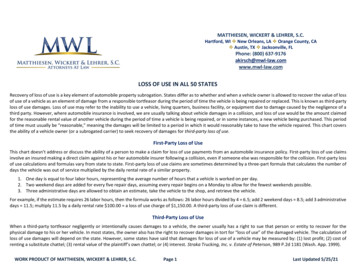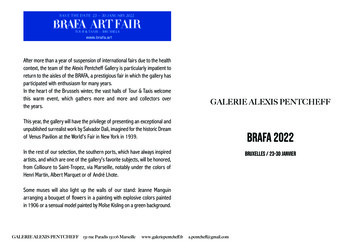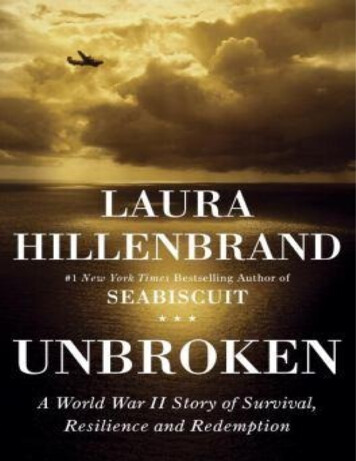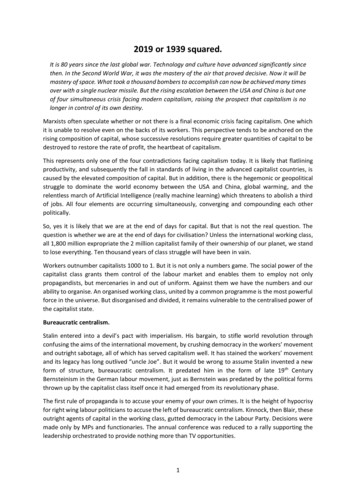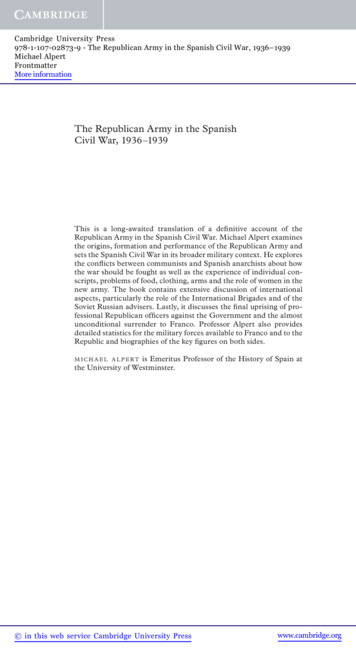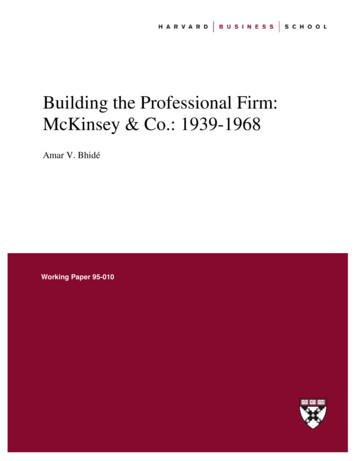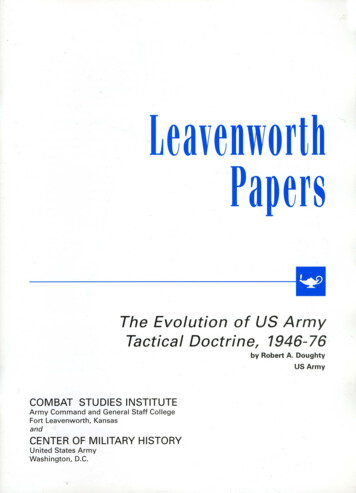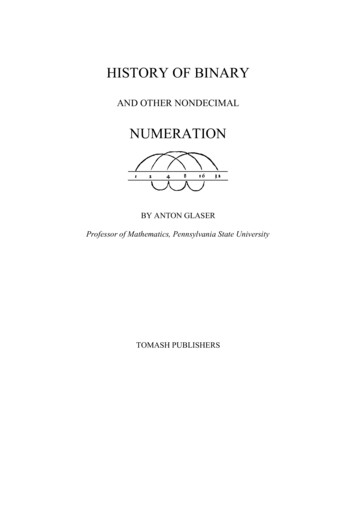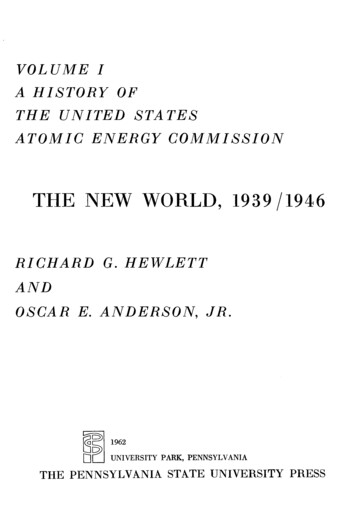
Transcription
VOLUME IA HISTORY OFTHE UNITED STATESATOMIC ENERGY COMMISSIONTHE NEW WORLD, 1939 /1946RICHARD G. HEWLETTANDOSCAR E. ANDERSON, JR.1962UNIVERSITY PARK, PENNSYLVANIATHE PENNSYLVANIA STATE UNIVERSITY PRESS
Library of Congress Catalog Card Number: 62-14633Designed by Marilyn Shobaken
CONTENTSFOREWORD BY THE CHAIRMAN,HISTORICAL ADVISORY COMMITTEEixPREFACExiv1 THE INHERITANCEHistorical setting, January, 1947; summary of AECinheritance.12 IN THE BEGINNINGDiscovery of fission; first efforts to gain federal support for nuclear research; growing interest in militarypotential; authority for an all-out investigation ofatomic weapons.93 EXPLORING THE ROUTES TO THE WEAPONOSRD efforts to select best production process; decision to expand project, June, 1942; transfer of responsibility to the Army; procurement and priorityproblems.534 COMMITMENTResearch and preliminary engineering on major production processes; decisions leading to the December,1942, report committing the United States to producing the bomb.84
THE NEW WORLD / 1939-1946vi5 RACE FOR THE BOMB: URANIUM 235Construction of Oak Ridge; evolution of the isotopeseparation plants from research through design, development, and construction in 1943 and early 1944.1166 RACE FOR THE BOMB: PLUTONIUMEvolution of the Oak Ridge and Hanford piles andseparation plants; selection of the Hanford site andconstruction of plant; administration and procurement.1747 A LABORATORY SET ON A HILLSelection of the Los Alamos site; organization of theweapons laboratory; research and development; implosion and the gun; crisis in the summer of 1944; effects of weapon prospects on strategic planning.2278 AN UNEASY PARTNERSHIPProblems of the Anglo-American alliance; end of interchange; Churchill's efforts to achieve a completelyjoint enterprise; Quebec Agreement, resumption of interchange; ore-control policies.2559 RACE FOR THE BOMB: HOMESTRETCHCongress and appropriations; procurement of ore anduranium supplies; completing the production plantsand initial operation, 1944-45; final development ofthe weapon.28910 THE QUEST FOR POSTWAR PLANNINGBush-Conant interest in postwar control; Metallurgical Laboratory concern for the future; Roosevelt,Churchill, and the Hyde Park Aide-Memoire; Britainand the French scientists; Stimson's last advice toRoosevelt; appointment of the Interim Committee.32211 TERRIBLE SWIFT SWORDAtomic bombs in the strategy against Japan; sessionsof the Interim Committee; scientific opinion and theScientific Panel; Alamogordo; Potsdam; victory overJapan.347
CONTENTS12 CONTROLLING THE ATOM: SEARCH FOR A POLICYDrafting domestic legislation; atomic energy in thepublic forum; Stimson's search for a policy for international control; Army pressure for legislation; thePresident's message of October 3, 1945.13 CONTROLLING THE ATOM: FROM POLICYTO ACTIONMay-Johnson bill; rise of the scientists' opposition;McMahon's Special Committee; Army-McMahon dispute; indecision on international control; TrumanAttlee-King conference; Byrnes's approach to theRussians.408428vii14 THE LEGISLATIVE BATTLEInitial reactions to the McMahon bill; winning Presidential support; Senate hearings, early 1946; Vandenberg amendment and civilian control; new conflictin the House; passage of the Atomic Energy Act of1946.48215 INTERNATIONAL CONTROL: LAST BEST HOPEUnited Nations Atomic Energy Commission; draftingthe Acheson-Lilienthal plan; Baruch's appointment asU. S. representative; evolution of the official U. S.plan.53116 INTERNATIONAL CONTROL: NO FLESHFOR THE SPIRITBikini test; reactions to the U. S. proposal; explanations of the American plan; stalemate with the Russians; Wallace controversy; report of the United Nations Atomic Energy Commission.17 A TIME OF TRANSITIONAppointment of the U. S. Atomic Energy Commission; Army management of the Manhattan project in1946; first Commission meetings; problems of transfer and the question of civilian control; transfer, December 31, 1946.580620
THE NEW WORLD / 1939-1946SOURCES657NOTES667APPENDICES1. The McMahon Bill (S. 1717)2. Financial Data714INDEX725
FOREWORD BY THE CHAIRMAN,HISTORICAL ADVISORY COMMITTEEixThe Historical Advisory Committee of the Atomic Energy Commission hailsthe completion of the first volume of the History with enthusiasm. We congratulate both the authors on the fairness and clarity of their presentationand the Commissioners on their decision to publish an unclassified historyand on their wisdom in leaving the authors a free hand subject only to thelimitations imposed by national security. All of the members of the AdvisoryCommittee are happy to testify to the scholarly world and to the general public that this book is a major, impartial and objective contribution to American history.No other development in our lifetime has been fraught with such consequences for good or evil as has atomic fission. None has raised such challenging questions for the historian, the economist, the armed forces, thescientists and the engineers. The wartime scientific developments producedsignificant new techniques in public administration which came to be morewidely used after the war, such as the enlistment of university and privatecontractors to perform new types of government activities. The fresh light thisvolume throws on the early history of these new techniques may prove helpfulin clarifying current problems of conflict of interest in the "military-industrialcomplex."Unlike the history of the proximity fuze the development of atomicweapons was an international achievement to which great contributions weremade by European as well as American scientists and engineers. All werespurred by the agonizing fear that the Nazis were well ahead of the free worldin the development of atomic weapons.Among the wealth of new materials brought to light by Dr. Hewlettand Dr. Anderson, many of the most interesting papers came from a sealedsafe containing the correspondence of Vannevar Bush and James B. Conantfrom 1940 to 1945. The ideas of these two scientific leaders became a part of
THE NEW WORLD / 1939-1946the Interim Committee plan and of the Stimson proposals presented in September, 1945. They thus underlay the Acheson-Lilienthal plan. The materialsfrom the sealed safe make possible for the first time a satisfactory account ofthe intricate wartime negotiations with Great Britain and Canada on atomicenergy.The authors have presented a clear account of the possible routes tothe bomb, of the obstacles blocking each path, and of the tensions built upduring the quest for solutions. Both the scientist and the lay reader will findthis not only the fullest and best documented but the most balanced narrativeof the greatest research enterprise of the Second World War.James P. Baxter, 3rdUNITED STATES ATOMIC ENERGY COMMISSIONHISTORICAL ADVISORY COMMITTEECHAIRMANJAMES P. BAXTER, 3RDWilliams CollegeJOHN M. BLUMYale UniversityJAMES L. CATEUniversity of ChicagoARTHUR H. COMPTONWashington UniversityFRANCIS T. MILESBrookhaven National LaboratoryDON K. PRICE, JR.Harvard UniversityGLENN T. SEABORGUniversity of California, Berkeley Resigned February 20, 1961, to become Chairman of the Atomic Energy Commission.
PREFACEThe first public announcement that the United States had entered the atomicage followed the blinding flash over Hiroshima, Japan, on August 6, 1945.Until that moment only a few score of Americans had seen the maj or outlines of the wartime project which produced the bomb. Six days later, theGovernment released Henry D. Smyth's report, A General Account of theDevelopment of Methods of Using Atomic Energy for Military Purposes Underthe Auspices of the United States Government, 1940-1945. Dr. Smyth chronicled the administrative and the technical history of the secret enterprise. Although the report was devoted primarily to "all the pertinent scientific information which can be released to the public at this time without violating theneeds of national security," Dr. Smyth saw fit to close with a broad, forwardlook at "The Questions Before the People." Some of his statements havegrown more pertinent with the passing years:. . . Here is a new tool for mankind, a tool of unimaginable destructive power. Its development raises many questions that must be answered in the near future. . . . These questions are not technical questions; they are political and social questions, and the answer given tothem may affect all mankind for generations. . . In a free countrylike ours, such questions should be debated by the people and decisions must be made by the people through their representatives. Thisis one reason for the release of this report.Despite Smyth's call for public discussion, the real issues posed by theexploitation of atomic energy failed to reach the American people during thesucceeding decade. The fault lay partly in the continuing need for securityrestrictions, partly in the layman's disinclination to acquire the rudimentarytechnical knowledge necessary to understand the impact of this new force inhis life. Politicians left technical details to the scientists; social scientists reacted with resignation or disdain to this newest manifestation of the scientificrevolution in the twentieth century. The relatively few persons who were
THE NEW WORLD / 1939-1946xiiprivileged to work behind the security barrier imposed by the Atomic EnergyAct of 1946 found themselves ever more isolated in a world their fellow citizens had never seen.Within the decade there were signs of a change. A new atomic energylaw in 1954 liberalized security restrictions in the interests of internationalco-operation and civilian uses of atomic energy. The widening gulf betweenthe physical and the social sciences caused growing concern. During 1957,the Atomic Energy Commission's tenth anniversary, one of the Commissioners remarked that he and his colleagues were making some of the most momentous decisions in American history without the benefit of an historian torecord the events. The discussion resulted in a decision to employ two professional historians, give them complete access to the files, and permit themto write—with no restrictions other than those imposed by national security—the story as they saw it. The Commission also established an HistoricalAdvisory Committee of distinguished, independent scholars in a variety ofdisciplines to give advice on policy matters and to review the work of the historians. Since most of the documentary evidence would not be available to thepublic for many years, the committee agreed to examine the sources andthereby provide a partial but effective substitute for independent scholarlycriticism.As the authors of the first volume in this series, we have tried to followthe lead of Dr. Smyth's closing sentences. From the outset it has been our intention to explain the effect of technological developments on policy decisionsat the national and international level. Our uncomfortable proximity to thepeople and events we are describing has not deterred us from seeking thelofty perspective of the historian; on the contrary, it seems to make that approach especially important. The following pages are more often narrativethan analytical, more often chronological than topical. The perspective is thehighest appropriate level in the federal government. Whatever the subject,whatever the essential significance of the event, whether and how we relatethat event depends on its relevance to the central perspective. We think thiscriterion makes for good history. Indeed, the complex interrelationships ofmodern science, industry, and government make it impossible to take anyother approach if history is to be kept within reasonable bounds.Yet the approach has the disadvantage of leaving voids in areas somereaders would expect to be filled. From our chosen point of view we cannotwrite a comprehensive history of any single organization, project, discipline,or period. We cannot mention every important participant or even contendthat those included are intrinsically more significant than those omitted. Inmany instances, we have been forced to depend on representative accounts.The greater technical detail on the electromagnetic separation process inChapters 4 and 5 reflects the relaxation of security restrictions and our effortto use this project as an example of wartime research and development. Likewise, the description of contracting procedures and contractor relationships
PREFACEin Chapter 6 is but a small sampling of an incredibly voluminous record. Notthat more exhaustive treatment would be unprofitable for some purposes. We,as historians, can but stake out the areas in which others with specialized interests may find rich ore.Our approach has also required us to devote most of this volume tothe Commission's inheritance rather than to the activities of the Commissionitself. Without that inheritance, the Commission's history has no meaning.For this reason we have emphasized the development of key production processes, the construction of physical plant, the advent of nuclear weapons, theorigins of the Atomic Energy Act of 1946, and the first steps toward international control. Important in its own right, this inheritance will serve as thefoundation for subsequent volumes in this series.We wish to emphasize (and it is a credit to the Commission that wecan do so) that this volume represents a completely independent, unrestricted history within the limits of national security. In no instance have webeen denied access to any records, facilities, or individuals sought in our research. The Commission and its operating staff have made no effort to establish the direction, emphasis, content, or conclusions of this volume. Even inthe few areas where security restrictions apply, the effect has been only toeliminate detail; we have never consciously distorted the facts to accommodate security. In short, the Commission has authorized the preparation of thisvolume, but we must bear responsibility for its content. This book, like all historical works, should stand on its own merits and be judged in the light ofsubsequent research as the work of the authors alone.In a work of this scope, we find it impossible to acknowledge our indebtedness to all those who have contributed to this volume. We must, however, mention those whose help more than warrants public recognition. First,we wish to express our deepest appreciation to the members of the HistoricalAdvisory Committee, whose names appear elsewhere in this volume. From theinitial proposals through the preliminary outlines, research, drafting, and redrafting, the committee proved a constant source of guidance and encouragement. The members not only fulfilled their responsibilities as scholars, butthey also proved wise and patient friends. The opportunity to work with themover the past four years has been one of the joys of our task.Within the AEC, we owe thanks to the various Commissioners whodemonstrated their confidence in us by endorsing this project, and particularly the three men who have served as Chairman during these years: Lewis L.Strauss, John A. McCone, and Glenn T. Seaborg. Clearly indispensable wasthe direction and support provided by Woodford B. McCool, the Secretary tothe Commission, who was among the first to see the need for this history, whohelped to establish the project, and who resisted magnificently the temptationplaguing every administrator to divert historians from their primary task tothe exigencies of daily deadlines and routine reports.Literally scores of Commission employees, both in headquarters and
THE NEW WORLD / 1939-1946xivthe field offices, had a part in preparing this volume. Greatest thanks must goto our research assistants, Alyce M. Birch and Mary Lee McIntyre, whose industry, loyalty, and forebearance are reflected on every page of this book.Both Francis Duncan, who read the manuscript and helped to prepare the index, and Helen Anderson, who executed the drawings, performed services farbeyond those required in their regular duties. Among the headquarters library and records staff, we wish to thank Elizabeth M. Cole, John L. Cook,Robert E. Devine, E. Jane Dossett, Velma E. Early, John E. Hans, William R. Johnson, Madeleine W. Losee, James D. Nuse, Jean M. O'Leary,Lillie B. Turner, Severina Tuttle, and Sara K. White. Murray L. Nash andCharles F. Knesel provided valuable guidance on classification problems;Clarence H. Little and his staff reproduced thousands of pages of manuscript,usually on short notice. Edward J. Brunenkant, J. William Young, andJames D. Cape spent long hours on publication matters. Elton P. Lord provided many of the photographs.Our research in the field was greatly facilitated by the following AECmanagers: Samuel R. Sapirie at Oak Ridge; James E. Travis at Hanford;Harold A. Fidler at San Francisco; Joseph C. Clarke at New York; andPaul A. Wilson at Los Alamos. At Oak Ridge, Charles Vanden Buick madearrangements to meet our many needs, James R. Langley helped us at therecords center, and James E. Westcott searched his photographic files. AtHanford, Milton R. Cydell sought out many elusive facts; Ralph V. Buttonfound many valuable documents in the records center. Among AEC contractor officials, we wish to thank Clark E. Center of the Union Carbide NuclearCompany, Oak Ridge; William E. Johnson of the General Electric Company,Hanford; Edwin M. McMillan of the Lawrence Radiation Laboratory, Berkeley; Norris E. Bradbury of the Los Alamos Scientific Laboratory; and Norman Hilberry of the Argonne National Laboratory. At Berkeley, Eleanor Davisson found many significant documents and Donald Cooksey permitted usto select photographs from his excellent collection. At Argonne, Hoylande D.Young and her staff searched dozens of laboratory files for documents of unusual interest.Without the help of many other Government agencies and institutions,it would have been impossible to write this book. Special appreciation is dueSherrod E. East, Edward J. Reese, and Harold Hufford of the National Archives; E. Taylor Parks of the Department of State; Rudolph A. Winnackerof the Department of Defense; Herman Kahn of the Roosevelt Library;Philip C. Brooks of the Truman Library; Nathan R. Reingold of the Libraryof Congress; and Arnold A. Shadrick of the Army Map Service.Many individuals graciously permitted us to use their private recordcollections: Herbert L. Anderson, Bernard M. Baruch, James F. Byrnes,John R. Dunning, Byron S. Miller, John A. Simpson, Jr., and Carroll L. Wilson. Just as valuable were the records furnished by the Federation of American Scientists, Iowa State University, the Stimson Literary Trust, Yale Uni-
PREFACEversity, and the University of Chicago. To all we express our appreciation.No less important was the assistance from those who subjected themselves to hours of insistent questioning during interviews. We thank them fortheir time and patience. Their names are listed in the note on the Sources.Last of all, we wish to express our gratitude to the hundreds of scientists, engineers, officers in the armed forces, Government officials, and privatecitizens whose names appear in the following pages, and to the thousands notthere recorded. They made this a stirring chapter in American history. Without them there would be no book; but more important, the United Statesmight not have been the first nation to enter the new world of the atom.Richard G. HewlettOscar E. Anderson, Jr.Germantown, MarylandFebruary, 1962xv
THEINHERITANCECHAPTER 1It was a dismal Thursday afternoon in Washington, the second day ofJanuary, 1947. Unnoticed among the hundreds of Government employees inthe New War Department Building, ten men gathered at a conference table ina cramped office on the sixth floor. Looking southeast across Twenty-firstStreet toward Constitution Avenue, they could see the Washington Monumenttowering into the cold rain that was turning five inches of New Year's snowinto a sea of slush. The four men on the far side of the table listened impassively as an aging graduate-school dean and a young Army colonel explained the intricacies of releasing wartime technical data without endangering national security.The drabness of the surroundings and the pedestrian character of thediscussion disguised the significance of the occasion. This was the first meeting of the United States Atomic Energy Commission since it had assumedcontrol of the plants, laboratories, equipment, and personnel assembled during the war to produce the atomic bomb.'Presiding that afternoon was the Chairman, David E. Lilienthal, acourageous lawyer and public servant who had risen to fame as head of theTennessee Valley Authority. Nearby sat Sumner T. Pike, a hearty New Englander and experienced businessman who was returning to Washingtonafter a term on the Securities and Exchange Commission. Next to him wasWilliam W. Waymack, an amiable gentleman farmer and newspaper editorfrom Iowa. The fourth Commissioner, Lewis L. Strauss, was a conservativeinvestment banker with an interest in science and politics. Robert F. Bacher,the only scientific member, was on special assignment in Los Alamos,New Mexico, inspecting the nation's stockpile of atomic weapons.Across the table was Carroll L. Wilson, a thirty-six-year-old engineerand former assistant to Karl T. Compton and Vannevar Bush. Just eight daysbefore, President Truman had named him the Commission's general man-
THE NEW WORLD / 1939-19462ager. With him were three other young men—Herbert S. Marks, the generalcounsel, George Fox Trowbridge, his assistant, and William T. Golden, administrative assistant to Commissioner Strauss. The elderly dean was RichardC. Tolman of the California Institute of Technology; the young Army officer,Colonel Kenneth E. Fields.To the Commission the President had transferred "properties and anorganization which, in magnitude, are comparable to the largest businessenterprises of the country." In the days after the bombing of Hiroshima,journalists had described the more spectacular features of the Army's production plants, laboratories, and technical installations. Most American newspapers carried photographs of the huge buildings among the ridges of EastTennessee or the concrete monoliths in the desert of eastern Washingtonwhere materials for the bomb were made. Almost as many ran photographsof Robert Oppenheimer and other scientists who had constructed the firstatomic weapons in a "super-secret" laboratory on an inaccessible mesa northwest of Santa Fe, New Mexico. The news services also described the researchin the scientific laboratories which the Government had established at Chicago, Columbia, and California.These, however, were just the highlights. Included in the transferwas a sprawling complex of men and equipment. The Army's transfer listran to thirty-seven installations in nineteen states and Canada. With the facilities the Army would transfer 254 military officers, 1,688 enlisted men,3,950 Government workers, and about 37,800 contractor employees. The entire project, representing a wartime investment of more than 2.2 billion,would cost an additional 300 million during the current fiscal year.The Army could describe precisely the physical inheritance, but it washarder to measure the political and economic legacy, the temper of the timesin which the new commission found itself. On New Year's Day, 1947, thePresident had taken a step toward ending World War II with a surpriseproclamation recognizing the termination of hostilities. The sixteen monthssince V-J Day had been a chaotic period of transition. While Harry S. Truman struggled with the burdens of the Presidency, the nation moved fromthe flush of victory into the somber realities of reconversion and readjustment—inflation, strikes, and political strife at home and starvation, nationalism, and new power relationships abroad.On the domestic scene, political fortunes were changing quickly.Franklin D. Roosevelt's death and the growing coalition between southernDemocrats and conservative Republicans in Congress had undermined themajorities the President had carried to victory in 1944. In the face of suchunpromising odds, his successor launched in September, 1945, a twenty-onepoint reconversion plan as a return to the "progressive" tradition and theNew Deal. Truman had to fight every inch of the way against the strongcurrent of reaction to wartime controls, high taxes, and "government fromWashington." A wave of strikes in major industries in 1946 alarmed business
THE INHERITANCE / CHAPTER 1interests while the President's harsh action against John L. Lewis for hisopen defiance of the Government in the coal strike alienated some of theparty's labor support. The Administration's efforts to extend price controls,rationing, and universal military training in peacetime met with failure.By the end of 1946, the Administration had made but two lasting achievements. One was the Employment Act, a mutilated version of the originalMurray bill but still a step in the direction of economic controls. The otherwas the Atomic Energy Act, which passed only after a year of acrimoniousdebate by 9 votes out of 200 in the House of Representatives. Within theAdministration itself, smouldering hostility ignited such explosions as theresignation of Harold L. Ickes as Secretary of the Interior and the dismissal ofHenry A. Wallace as Secretary of Commerce. These awkward episodes, thePresident's failure to control Congress, and the inflation that occurred withthe abandonment of price controls just before the November elections gavethe Republicans their most effective slogan, "Had Enough?"That 1946 would be a Republican year seemed certain, but few expected the landslide that occurred at the polls in November. Gaining twelveseats in the Senate and more than fifty in the House, the GOP took control ofCongress and captured governorships in twenty-five of thirty-two nonSouthern states. When the Eightieth Congress assembled on January 3,Arthur H. Vandenberg became president pro tempore of the Senate andJoseph W. Martin speaker of the House. Robert A. Taft, the Republicanpower in the Senate, stepped aside to permit Wallace H. White of Maine toserve as Senate majority leader. Taft was reserving for himself the chairmanship of the Senate Labor Committee, which would seek legislation to prevent recurrence of the strikes that had paralyzed the nation in 1946.The character of the Senate, which would pass on the interim appointments to the Atomic Energy Commission, seemed transformed by thepresence of such newcomers as Joseph R. McCarthy of Wisconsin, HenryCabot Lodge, Jr., of Massachusetts, Irving M. Ives of New York, EdwardMartin of Pennsylvania, Arthur V. Watkins of Utah, and John W. Bricker ofOhio. New members of the House included some young war veterans destinedto make their mark: William G. Stratton of Illinois, Richard M. Nixon ofCalifornia, and John F. Kennedy of Massachusetts.Back in power after fourteen years, the Republicans were in afighting mood as they talked of a 20-per-cent cut in federal taxes and appropriations, a drastic revision of the Wagner Labor Act, complete reorganization of the housing program, and a critical examination of reciprocaltrade policies and foreign spending. Assuming that the Republican nomineein 1948 would succeed Truman as President, the principal aspirants were already engaged in a struggle for power. Robert A. Taft, Senate spokesmanfor the Midwest, seemed the leading contender. Thomas E. Dewey hadbounced back from his defeat in 1944 with a resounding victory in thegubernatorial race in New York. Not out of the running were a dozen other
THE NEW WORLD / 1939-19464hopefuls led by Harold E. Stassen of Minnesota, who had already announcedhimself a candidate.Developments abroad looked no more promising for the Administration than did those at home. Though farm output in the United States hit arecord high in 1946, millions of Europeans faced starvation. The devastationin Germany continued to tax the descriptive powers of American journalists. France was threatened by inflation and colonial unrest. The UnitedKingdom, for which the war had proved almost fatal, accepted indefiniterationing of consumer goods and transferred its coal mines to governmentownership as a first step toward nationalizing basic industries.The upheaval of war and the collapse of Europe stimulated politicaland economic aspirations throughout the world. In the Middle East, the British found themselves caught in the cross fire of Jewish and Arab nationalism.In India, Mahatma Gandhi sparked a new drive for independence. SoutheastAsia was in tumult, and China remained an enigma. Despite a year of painful negotiation, General George C. Marshall had been unable to quench thefires of civil war which threatened to disrupt all Asia. In the Far East, onlyJapan, now under the firm hand of General Douglas MacArthur, seemedheaded toward stability.With the decline of Britain and France came the accelerated rise of theSoviet Union. In 1945, there had been confidence that somehow the victoriousallies could establish a new era of peace and human freedom. But this dreamgrew dim in 1946, when countries bordering the Communist world fromGermany to Korea felt the aggressive pressure of Soviet strength.The United Nations had yet to prove itself. Secretary-General TrygveH. Lie warned that while the new association of states had laid a soundfoundation on which to build peace, the state of the world left no room for"easy optimism." Certainly this judgment was borne out by the experience ofthe United Nations Atomic Energy Commission. After six months of negotiation, American delegate Bernard M. Baruch found the United States and theSoviet Union distressingly far apart on the requirements for effective international control.The survival of western democracy seemed to depend upon the UnitedStates. Yet Americans were obviously uncomfortable with
THE NEW WORLD / 1939-1946 privileged to work behind the security barrier imposed by the Atomic Energy Act of 1946 found themselves ever more isolated in a world their fellow citi-zens had never seen. Within the decade there were signs of a change. A new atomic energy law in 1954 liberalize

